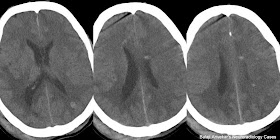A 22 yo female with history of mild headache came for MRI evaluation of Brain.
Routine parenchymal sequences shows:
No significant signal abnormality in brain parenchyma.
However axial T2 sections at the level of sella show non visualization of normal T2 flow voids of cavernous portion of ICA in para sellar region on either side.
So, followed by MR Angiography of Brain and Neck.
So, followed by MR Angiography of Brain and Neck.
Non contrast MR Angiography 3 D TOF for Brain and 2 D TOF for neck shows:
- Non visualization of cervical portion of ICAs on either side except a small stem at its origin.
- Intra cranial ICA petrous portion show marked diffuse narrowing with non visualization of its cavernous and supra clinoid portions.
- Both the MCAs and ACAs filled via posterior circulation via PComs, predominantly via dominant right PCom. Dominant Basilar and Vertebrals.
Congenital hypoplasia or Acquired stenosis?
 In this case the non visualization of ICAs on MR Angio can be secondary to congenital hypoplasia or acquired severe stenosis at its origin. But here it appears to be the Congenital hypoplasia as patient is asymptomatic for the particular finding, dominant right PCom and Vertebro basilar system taking care of intra cranial blood supply. Axial CT sections at the level of base of skull show smaller caliber of carotid canal which corresponds to petrous portion of intra cranial ICAs supports Congenital Hypoplasia. Agenesis is unlikely as in Agenesis the carotid canals would have been completely absent.
In this case the non visualization of ICAs on MR Angio can be secondary to congenital hypoplasia or acquired severe stenosis at its origin. But here it appears to be the Congenital hypoplasia as patient is asymptomatic for the particular finding, dominant right PCom and Vertebro basilar system taking care of intra cranial blood supply. Axial CT sections at the level of base of skull show smaller caliber of carotid canal which corresponds to petrous portion of intra cranial ICAs supports Congenital Hypoplasia. Agenesis is unlikely as in Agenesis the carotid canals would have been completely absent.Final impression: Bilateral hypoplastic ICAs.
Discussion:
Agenesis, aplasia, and hypoplasia of ICAs are rare congenital anomalies.
Incidence is less than 0.01% of the population.
May be unilateral or bilateral. Unilateral is more common than bilateral with left sided predominance by ~3:1.
Collateral blood flow in these cases most commonly through the circle of Willis, less commonly via persistent embryonic vessels and in rare occasions from transcranial collaterals from ECA, allowing these patients to remain asymptomatic or discovered incidentally.
Recognition of these anomalies and differentiating them form acquired causes of non visualisation of artery on MR Angiography sequences is important for diagnosis and further planning.
The exact cause of these developmental anomalies has not been established and is out of imaging consensus. The postulated causes include an intra uterine insult to the developing embryo. The mechanical and hemodynamic stresses placed on the embryo like exaggerated neck folding of the embryo or constriction by amniotic bands.
Similar Case : ICA unilateral congenital hypoplasia
Discussion:
Agenesis, aplasia, and hypoplasia of ICAs are rare congenital anomalies.
Incidence is less than 0.01% of the population.
May be unilateral or bilateral. Unilateral is more common than bilateral with left sided predominance by ~3:1.
Collateral blood flow in these cases most commonly through the circle of Willis, less commonly via persistent embryonic vessels and in rare occasions from transcranial collaterals from ECA, allowing these patients to remain asymptomatic or discovered incidentally.
Recognition of these anomalies and differentiating them form acquired causes of non visualisation of artery on MR Angiography sequences is important for diagnosis and further planning.
Etiology:
Differentiating Agenesis from Aplasia:
Absence of artery that is non visualisation of normal flow voids of artery on parenchymal sequences or flow related signal on Angiography is a general term.
Agenesis is complete failure of an organ to develop.
Aplasia is lack of development (but its precursor did exist at one time), and
Hypoplasia as incomplete development.
In Aplasia of ICA, a tiny fibrous band may be the only remnant of the ICA which may not be depicated on angiography alone. To differentiate Aplasia from Agenesis, evaluation of the skull base can be of great help. Axial CT sections bone window images are the best. The presence or absence of the carotid canal on skull base sections can be used for distinguishing aplasia from agenesis. As presence of the ICA or its precursor is a prerequisite for development of the carotid canal at 5 to 6 weeks of gestation, demonstrating presence of carotid canal on skull base sections rules out Agenesis. Demonstrating the smaller size of carotid canal compared to opposite side can be used to differentiate hypoplasia from acquired causes of reduced caliber of ICA that is stenosis.
Reference:
Congenital Absence of the Internal Carotid Artery: Case Reports and Review of the Collateral Circulation; Curtis A. Given IIa, Frank Huang-Hellingera.






















